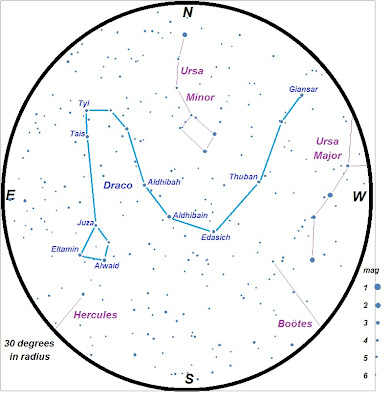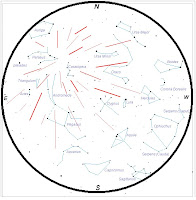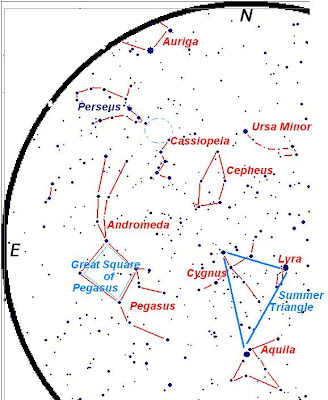.....The second constellation joined by the Summer Triangle is Aquila, the Eagle. (We move east in our examination of the constellations, and we have covered enough now to see blue constellations to the south and west, and red, or "not yet covered" mostly to the west.) Altair, the bright star bracketed by fainter stars to the northwest and southeast, is the bottom star of the Summer Triangle, and the brightest star in Aquila. Altair is also fairly close to Earth. The light that you see tonight left on November 15th, 1994 (plus or minus a month).
.....Here is the "Binocular View" of most of Aquila, with the names of the named stars included. This includes some very long names for very faint stars. I refer to Deneb el Okab Borealis/Australis, or "The tail of the eagle north/south". (The Arabs clearly visualized this image differently than I have drawn it here.) Deneb el Okab Borealis has a visual magnitude of 4.00, making this one of the faintest named stars we have covered.
.....The next step, on the next go 'round, would be to have more detailed maps of the cool clusters, nebulae, galaxies, etc., to be found in Aquila especially since the summer Milky Way passes through the constellation ... but there are none to be easily found. There are no Messier Objects, no Caldwell Objects (a list constructed by Sir Patrick Caldwell-Moore to include material Messier didn't), and the Sky Atlas 2000.0 Companion (to one of the most prominent star atlases extant) has numerous objects, with notations like "extremely faint", "not well detached", "appears stellar". All of the cool thing in Aquila seemed to have slipped to bordering constellations. (Sagitta, the faint constellation above Aquila, has three cool deep-sky objects.)
.....So let's digress into eagles in general. There are a lot of stars named "Something, something eagle", because, well, eagles are cool. Eurasia has about fifty types of eagles, while North America has two. This was unfortunate, as the first country to become independent in North America (the United States of America) took the bald eagle as its symbol, Mexico put the golden eagle on its flag, and Canada got ... the loon.
 .....Countries all over the world have used an eagle as a symbol. This makes sense. When you see an eagle on a flag, seal, official souvenir baseball cap, you think, "I wonder which aspect they are going for: freedom, vision, heck, even apex predator?"
.....Countries all over the world have used an eagle as a symbol. This makes sense. When you see an eagle on a flag, seal, official souvenir baseball cap, you think, "I wonder which aspect they are going for: freedom, vision, heck, even apex predator?" .....As opposed to the alarmingly common two-headed eagle, which only brings to mind the question, "How many hit points does it have?" (And yes, out of all my choices, I am choosing to pick on Austria-Hungary, a nation that has been defunct for coming up on a century. You never know what people are going to get peeved over.
.....As opposed to the alarmingly common two-headed eagle, which only brings to mind the question, "How many hit points does it have?" (And yes, out of all my choices, I am choosing to pick on Austria-Hungary, a nation that has been defunct for coming up on a century. You never know what people are going to get peeved over......Let's sum up. Using the symbol of an eagle (one head, left), you get this. Use the two-headed eagle (right), you get, "Ahhhh! AAAHHHH! Someone protect the CHILDREN!"















